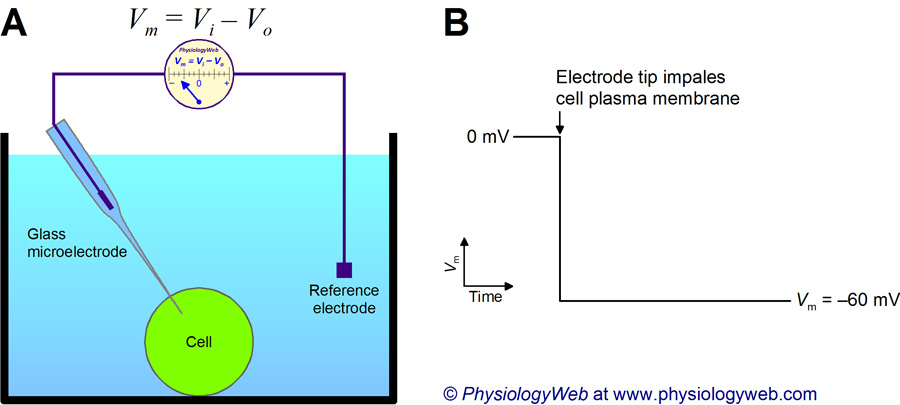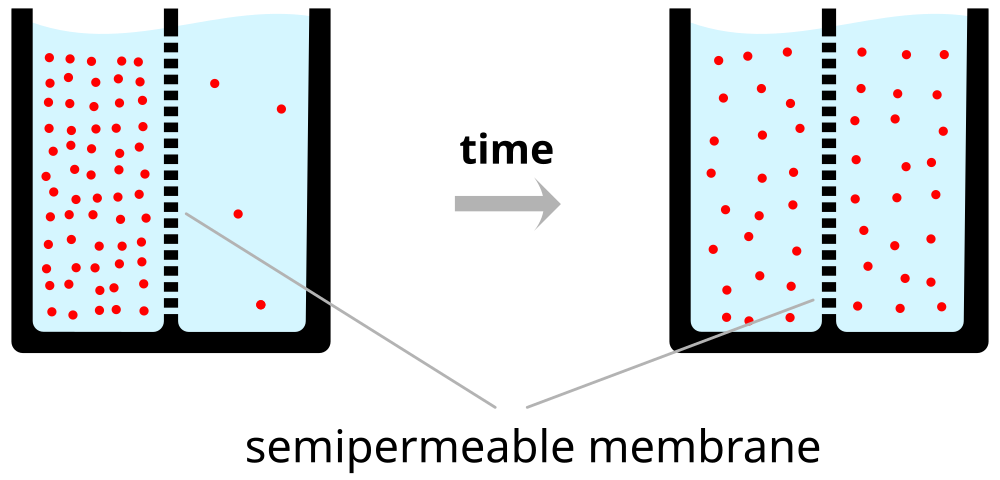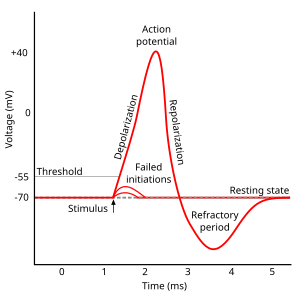2019-01-30 17:09:56
We are the champIONs (3:47)
Measuring potentials in actual neurons (4:20)
Today's Topics
- Exam 1 in-class next Thursday
- Mind maps/concept maps
- Warm-up
- Electrical communication in neurons
- The action potential
- Wherefore brains
A mind map/concept map
Warm-up
Which type of glial cell produces myelin for neurons in the CNS?
- A. Astrocytes
- B. Oligodendrocytes
- C. Schwann cells
- D. Microglia
Which type of glial cell produces myelin for neurons in the CNS?
- A. Astrocytes
- B. Oligodendrocytes
- C. Schwann cells
- D. Microglia
How many neurons are there in the human brain?
- A. 100 million
- B. 100 billion
- C. ~86 billion
- D. ~86 million
How many neurons are there in the human brain?
- A. 100 million
- B. 100 billion
- C. ~86 billion
- D. ~86 million
What part of the neuron receives the majority of input from other neurons?
- A. The axon
- B. The terminal button
- C. The soma
- D. The dendrites
What part of the neuron receives the majority of input from other neurons?
- A. The axon
- B. The terminal button
- C. The soma
- D. The dendrites
Electrical communication in neurons
Resting potential
Where does the resting potential come from?
- Ions (charged atoms)
- Ion channels
- Separation between charges
- A balance of forces
We are the champIONs, my friend
- Potassium, \(K^+\)
- Sodium, \(Na^+\)
- Chloride, \(Cl^-\)
- Organic anions, \(A^-\)
Resting potential arises from
- A balance of forces
- Force of diffusion
- Electrostatic force
- Forces cause ion flows across membrane
- Ion channels allow ion flow
Ion channels
- Openings in neural membrane
- Selective for specific ions
- Vary in permeability (how readily ions flow)
- Types
- Passive/leak (always open)
- Voltage-gated
- Ligand-gated (chemically-gated)
- Transporters/pumps
Ion channels
Neuron at rest permeable to \(K^+\)
- Passive \(K^+\) channels open
- [\(K^+\)] concentration inside >> outside
- \(K^+\) flows out
Force of diffusion
Force of diffusion
Neuron at rest permeable to \(K^+\)
- Organic anions (\(A^-\)) to large to move outside of cell
- \(A^-\) and \(K^+\) largely in balance == no net internal charge
- \(K^+\) outflow creates charge separation: \(K^+\) <-> \(A^-\)
- Charge separation creates a voltage
- Outside +/inside -
- Voltage build-up stops outflow of \(K^+\)
The resting potential
Balance of forces in the neuron at rest
- Force of diffusion
- \(K^+\) moves from high concentration (inside) to low (outside)
Balance of forces in the neuron at rest
- Electrostatic force
- Voltage build-up stops \(K^+\) outflow
- Specific voltage called equilibrium potential for \(K^+\)+
- \(K^+\) positive, so equilibrium potential negative (w/ respect to outside)
- Equilibrium potential close to neuron resting potential
Equilibrium potential and Nernst equation
Equilibrium potentials calculated under typical conditions
| Ion | [inside] | [outside] | Voltage |
|---|---|---|---|
| \(K^+\) | ~150 mM | ~4 mM | ~ -90 mV |
| \(Na^+\) | ~10 mM | ~140 mM | ~ +55-60 mV |
| \(Cl^-\) | ~10 mM | ~110 mM | - 65-80 mV |
Resting potential ≠ \(K^+\) equilibrium potential
- Resting potential not just due to \(K^+\)
- Other ions flow
- Resting potential == net effects of all ion flows across membrane
Goldman-Hodgkin-Katz equation
\(Na^+\) role
- \(Na^+\) concentrated outside neuron
- Membrane at rest not very permeable to \(Na^+\)
- Some, but not much \(Na^+\) flows in
- \(Na^+\) has equilibrium potential ~ + 60 mV
- Equilibrium potential is positive (with respect to outside)
- Would need positive interior to keep \(Na^+\) from flowing in
Electrical circuit model
Summary of forces in neuron at rest
| Ion | Concentration gradient | Electrostatic force | Permeability |
|---|---|---|---|
| \(K^+\) | Inside >> Outside | - (pulls \(K^+\) in) | Higher |
| \(Na^+\) | Outside >> Inside | - (pulls \(Na^+\) in) | Lower |
Party On
- Annie (\(A^-\)) was having a party.
- Used to date Nate (\(Na^+\)), but now sees Karl (\(K^+\))
- Hired bouncers called
- "The Channels"
- Let Karl and friends in or out, keep Nate out
- Annie's friends (\(A^-\)) and Karl's (\(K^+\)) mostly inside
- Nate and friends (\(Na^+\)) mostly outside
- Claudia (\(Cl^-\)) tagging along
What happens if something changes?
- Easier for Karl [\(K^+\)] to exit?
- Easier for Nate [\(Na^+\)] to enter?
- Some action!
Action potential
Action potential
- Threshold of excitation
- Increase (rising phase/depolarization)
- Peak
- at positive voltage
- Decline (falling phase/repolarization)
- Return to resting potential (refractory period)
Action potential break-down
| Phase | Neuron State |
|---|---|
| Rise to threshold | + input makes membrane potential more + |
| Rising phase | Voltage-gated \(Na^+\) channels open, \(Na^+\) flows in |
| Peak | Voltage-gated \(Na^+\) channels close and deactivate; voltage-gated \(K^+\) channels open |
| Falling phase | \(K^+\) flows out |
| Refractory period | \(Na^+\)/\(K^+\) pump restores [\(Na^+\)], [\(K^+\)]; voltage-gated \(K^+\) channels close |
What's a \(Na^+\)/\(K^+\) pump?
- Enzyme (\(Na^+\)/\(K^+\) ATP-ase) embedded in neuron membrane
- Pumps \(Na^+\) and \(K^+\) against concentration gradients
- \(Na^+\) out; \(K^+\) in
- Uses ATP or chemical energy
Example in another domain
Refractory periods
- Absolute
- Cannot generate action potential (AP) no matter the size of the stimulus
- Voltage-gated \(Na^+\) channels inactivated, reactivate in time.
- Relative
- Can generate AP with larg(er) stimulus
- Some voltage-gated \(K^+\) channels still open
- Refractory periods put 'spaces' between APs
Generating APs
- Axon hillock
- Portion of soma adjacent to axon
- Integrates/sums input to soma
- Axon initial segment
- Umyelinated portion of axon adjacent to soma
- Voltage-gated \(Na^+\) and \(K^+\) channels exposed
- If sum of input to soma > threshold, voltage-gated \(Na^+\) channels open
Axon hillock, axon initial segment

Axon Hillock" by M.aljar3i - Own work. Licensed under CC BY-SA 3.0 via Commons
Next time
- Putting it all together
- How action potentials propagate
- Review for Exam 1
Wherefore brains?
Why brains?
Escherichia Coli (E. Coli)
- Tiny, single-celled bacterium
- Feeds on glucose
- Chemo ("taste") receptors on surface membrane
- Flagellum for movement
- Food concentration regulates duration of "move" phase
- ~4 ms for chemical signal to diffuse from anterior/posterior
Paramecium
- 300K larger than E. Coli
- Propulsion through coordinated beating of cilia
- Diffusion from head to tail ~40 s!
- Use electrical signaling instead
- Na+ channel opens (e.g., when stretched)
- Voltage-gated Ca++ channels open, Ca++ enters, triggers cilia
- Signal across cell within ms
Caenorhabditis Elegans (C. Elegans)
- ~10x larger than paramecium
- 302 neurons + 56 glial cells (out of 959)
- Swim, forage, mate
Why brains?
- For neurons
- Bigger bodies
- Live longer
- Do more, do it faster







